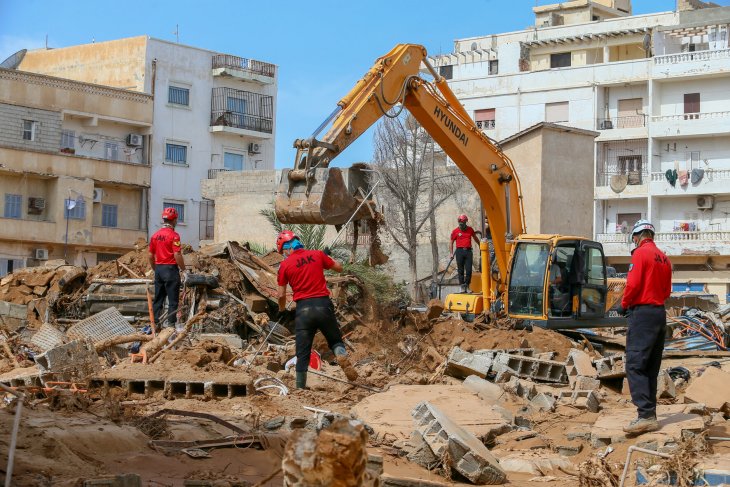As Libya’s death toll rises due to the massive floods triggered by Hurricane Daniel, it’s normal to wonder if such a catastrophe could have been prevented.

Search and rescue operation teams continue their efforts after the floods caused by the Storm Daniel ravaged the region, in Derna, Libya on September 17, 2023. Photo: Halil Fidan/Anadolu Agency via Getty Images
New research published this month gives a better understanding of how and why countries affected by armed conflict are more vulnerable to disaster.
Over 5,000 people lost their lives in Libya as torrential rain caused two dams to burst near the coastal city of Derna. Relentless rain devastated much of the city, washing entire neighborhoods into the sea and claiming thousands of lives, while leaving tens of thousands without shelter. While authorities and the media have largely attributed the catastrophe to a disaster caused by climate change, evidence suggests that it could have been largely prevented or its impacts mitigated.
A country ill-prepared
Libya has been torn apart by years of conflict, rendering it ill-prepared to face the devastation of Hurricane Daniel. The nation is still under the governance of two rival administrations, complicating and slowing down rescue and aid efforts. In addition, Libya’s infrastructure has suffered from neglect over more than a decade of political turmoil.
The second tragedy after the horrific loss of life, is that we had the knowledge and capability to do better.
A study we just published on how armed conflict contributes to disaster vulnerability found that in countries experiencing armed conflict, the death rate due to disasters is an incredible 34 percent higher, and disasters occur 5 percent more frequently.
We found multiple reasons why this happens. Conflict causes destruction, and prevents the development and maintenance of infrastructure essential to prevent disasters, such as the dams that have been left in disrepair throughout Libya.
Protracted wars damage a country’s economy, reducing opportunities to invest in building and maintaining low-risk livelihoods, and increasing people’s vulnerability, making them more susceptible to be affected by natural hazards, such as flooding and wildfires.
For example, people are less likely to have savings or reserves in place when disaster hits. Communities often do not have the resources to commit to longer-term planning to build more resilient livelihoods away from risk zones. Two large dams built in the narrow valley in Derna were highly vulnerable because poorly constructed housing built close to the river had become increasingly dense and high-rise.
In addition, wars often force people to flee their homes, leaving them in displacement camps and sheltering with families or friends. This increases their vulnerability to disasters. For example, when flooding has hit the world’s largest refugee site in Bangladesh, Rohingya families sheltering there had nowhere to flee to, and were stuck living in flooded areas, easily catching illness and disease. This shows that disasters occur more due to people’s vulnerability, and social and political decisions than due to exposure to hazards. Climate change can impact the frequency and intensity of these hazards but if communities are well-prepared for them, these events do not become disasters.
In the case of Libya, while the civil war ended in 2020, the political situation in the country remains fragile. The UN-facilitated ceasefire in 2020 succeeded in ending militarized clashes between eastern and western armed groups, but much remains to be done to disarm, demobilize and reintegrate militants.
The interaction between conflict and disaster
Beyond ending the violence, communities need to be provided with a safe environment that allows them to prepare and reduce the risk of being affected by disasters. The devastation caused by disasters like the Libya floods show the interaction between conflict and disaster.
Without the recent civil war, the death toll would not have reached the proportion we witness today. Not only should addressing disaster risks get more immediate attention in the aftermath of war, we can also conclude that conflict prevention, resolution and peace building should be priority approaches to disaster risk reduction anywhere in the world.
Further information
If you would like to know more about the research into how armed conflict contributes to disaster vulnerability, watch this short one-minute video.
The authors
Nicolás Caso is a Research Assistant at PRIO’s Migration Centre. His research covers diverse aspects of human development including migration, disaster, and conflict studies. At PRIO he currently works mainly conducting quantitative analyses for two high-profile large projects Aligning Migration Management and the Migration–Development Nexus (MIGNEX) and Future Migration as Present Fact (FUMI). Before joining PRIO he researched the interaction between conflict and disasters as part of the NWO funded project “When disasters meet conflict“.
Rodrigo Mena is Assistant Professor of Disasters and Humanitarian Studies at The International Institute of Social Studies of Erasmus University Rotterdam. Dr. Mena has studied and worked in humanitarian assistance/aid, disaster governance, and environmental sociology for almost twenty years, especially in conflict-affected and vulnerable settings. He lectures on humanitarian action, disaster risk reduction, methodology, and safety and security for in-situ/fieldwork research.